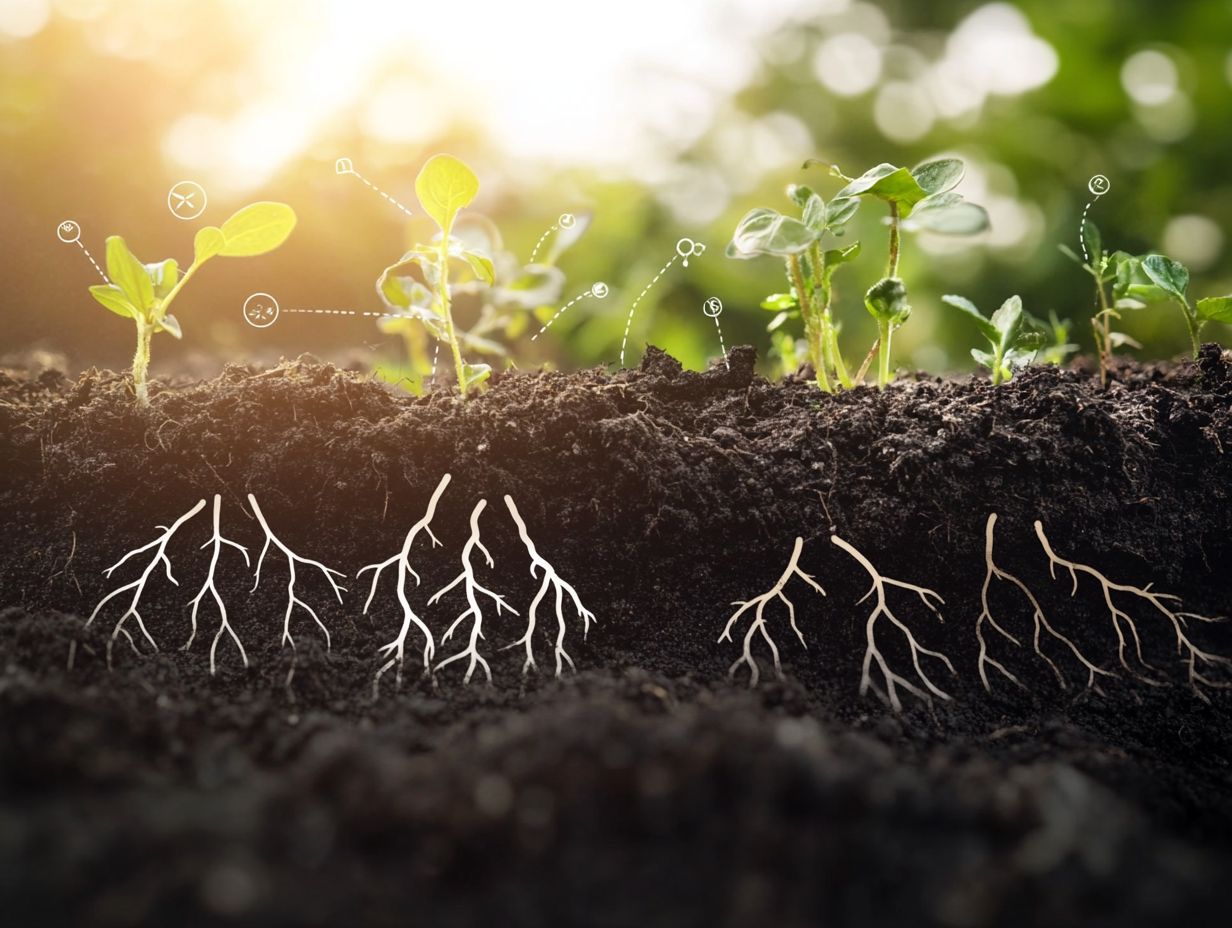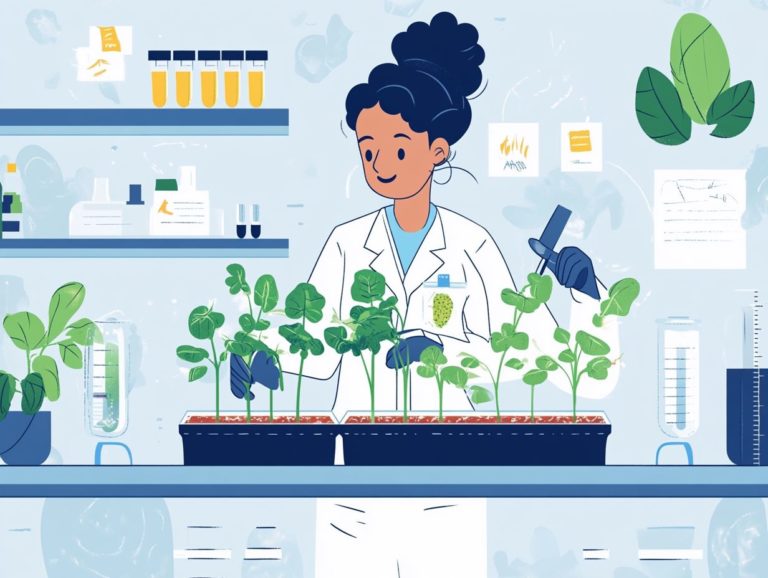5 Key Factors Influencing Nutrient Uptake
Understanding the intricate relationship between plants and their environment is vital for achieving success in gardening and agriculture. This article delves into five key factors that significantly influence nutrient uptake:
- The quality and composition of soil.
- The specific plant species and their genetics.
- Water availability.
- Environmental elements.
- Effective nutrient management practices.
You ll discover how plants absorb nutrients, identify the most crucial ones for robust growth, and appreciate the importance of soil testing. By the end of this journey, you will gain valuable insights into enhancing nutrient uptake and sidestepping potential pitfalls that could impede plant development. Ready to cultivate a thriving garden? Let s dig in!
Contents
Key Takeaways:

- Soil quality and composition play a crucial role in nutrient uptake by plants. It s important to maintain balanced soil pH and ensure the presence of essential nutrients.
- The genetic makeup of a plant and its species also influence its ability to absorb nutrients. Choosing the right plant species and utilizing modified varieties can improve nutrient uptake.
- Water availability is key to nutrient uptake as it helps transport nutrients from the soil to the plant. Proper irrigation and water management practices are crucial for optimal nutrient uptake.
1. Soil Quality and Composition
Soil quality and composition are critical to the growth and health of cannabis plants. They directly influence nutrient availability, moisture levels, and overall plant development. Understanding the interconnectedness of soil characteristics like pH, temperature, and aeration is essential for cultivating robust crops.
The organic composition of your soil, rich in nutrients such as nitrogen and phosphorus, boosts enzymatic activity and fosters microbial interactions, enabling optimal nutrient uptake through strong root systems.
Conducting soil tests is vital; they reveal any nutrient deficiencies or excesses that might impact your plants’ vigor. Moisture levels in the soil are also crucial; too much or too little can hinder root functions and ultimately affect nutrient absorption. Proper aeration prevents root rot and allows roots to breathe freely.
Using organic compost can significantly enhance soil structure and quality, providing a slow release of essential nutrients while improving moisture retention. This thoughtful combination creates a thriving environment, ensuring your cannabis plants can reach their full potential.
2. Plant Species and Genetics
The unique genetics of cannabis plants play a crucial role in shaping their growth patterns, nutrient needs, and overall resilience to environmental stressors. These traits create a diverse capacity for nutrient uptake, meaning certain strains are better equipped for specific soil compositions.
Some varieties can flourish in nutrient-poor soils, skillfully extracting what they need, while others demand richer substrates to reach their full potential. This adaptability is influenced by genetic factors, such as root structure and beneficial fungi that help plants absorb nutrients, enhancing nutrient absorption.
By understanding these differences, you can select the most suitable strains for your growing conditions, ultimately resulting in healthier plants and improved yields.
3. Water Availability
Water availability is a fundamental factor influencing nutrient uptake in cannabis plants, as it enables the essential translocation of nutrients from the soil to the roots. Optimizing soil moisture levels allows roots to efficiently absorb vital elements like nitrogen, phosphorus, and potassium, all critical for robust growth.
Poor water quality and mismanaged irrigation practices severely hinder this essential process, potentially leading to nutrient deficiencies. Both excessive and insufficient watering disrupt the soil’s pH and texture, complicating nutrient availability even further. Therefore, adopting sustainable irrigation methods enhances water quality and promotes overall plant health.
4. Environmental Factors

Environmental factors like temperature and pH are pivotal in shaping the health and growth of your cannabis plants. They influence everything from the way enzymes work to microbial communities in the soil.
These variables significantly impact the bioavailability of essential nutrients. This, in turn, directly affects the plant’s metabolic processes.
For example, temperature fluctuations can either accelerate or slow down nutrient uptake rates. Meanwhile, extreme pH levels can obstruct the plant’s ability to absorb crucial minerals.
Your plants are overachievers. They showcase remarkable feedback mechanisms that help them adjust to environmental variations.
Optimize soil pH and monitor temperature to keep your plants healthy. By doing so, you can ensure that your plants remain robust, capable of flourishing even in less-than-ideal environments.
5. Nutrient Management Practices
Implementing effective nutrient management practices is crucial for optimizing the growth of your cannabis plants. Ensure they receive the perfect balance of essential nutrients like nitrogen and phosphorus.
Get started with organic fertilization techniques now! Use naturally sourced materials like fish emulsion or seaweed extract to boost your soil’s nutrient levels.
Composting serves as another vital strategy. It enriches the soil with essential microorganisms while enhancing its structure, which improves water retention and aeration.
These methods work together to facilitate greater nutrient availability and uptake. This enables your plants to thrive by absorbing exactly what they need to reach their full potential.
Incorporating crop rotation and cover cropping will further enhance soil health over time. This creates a sustainable ecosystem that benefits both your plants and the surrounding environment.
How Do Nutrients Get Absorbed by Plants?
Nutrient absorption in plants unfolds through intricate processes that involve the roots, their interaction with the soil, and the vital role of a type of fungus that helps plants absorb nutrients, which significantly enhances the plant’s nutrient uptake capabilities.
These roots are not merely passive connectors; they actively absorb water and essential minerals from the soil. This facilitates the movement of these nutrients through specialized pathways.
The xylem takes center stage in this process, transporting water and dissolved minerals upward from the roots to the rest of the plant. Meanwhile, the phloem distributes the products of photosynthesis primarily sugars from the leaves to growing tissues and storage organs.
Environmental conditions such as temperature, humidity, and soil nutrient content are pivotal in determining the efficiency of this transport system. For example, during drought conditions, water absorption can falter, leading to a decrease in nutrient transport.
In contrast, maintaining optimal moisture levels can significantly enhance the functionality of both the xylem and phloem.
What Are the Most Important Nutrients for Plant Growth?
Key nutrients for your plant’s growth include nitrogen, phosphorus, calcium, and magnesium, each playing an essential role in the physiological processes of cannabis.
Nitrogen is vital for chlorophyll production, enabling your plants to efficiently harness sunlight during photosynthesis and convert it into energy.
Phosphorus is crucial for energy transfer within the plant, particularly in the production of ATP, which powers cellular activities.
Calcium acts as a structural cornerstone for cell walls and is key for enzymatic functions.
Magnesium plays a pivotal role in synthesizing chlorophyll and enhancing nutrient absorption.
If you find any of these nutrients lacking, your plants might suffer from stunted growth, yellowing leaves, and overall poor health. This ultimately impacts the yield and quality of your harvest.
How Can Soil Testing Help with Nutrient Uptake?

Soil testing is invaluable for determining nutrient availability, pH levels, and overall soil health.
These elements guide effective nutrient management in cannabis cultivation.
By analyzing these key factors, you can accurately assess the specific needs of your plants. This ensures optimal growth and yield.
The soil testing process typically involves collecting samples from various areas of your growing space. After sending them off to a lab for analysis, you will decipher the results, revealing nutrient concentrations and pH variations.
Understanding the implications of these results is crucial as a cultivator. If certain nutrients are lacking, you can amend the soil with fertilizers specifically tailored to correct those deficiencies. Adjusting pH levels creates a better growing environment, maximizing nutrient uptake and promoting robust plant health.
What Are the Common Nutrient Deficiencies in Plants?
Common nutrient deficiencies in cannabis plants include nitrogen, phosphorus, and potassium. If you don t address these promptly, you may experience stunted growth and reduced yields.
You ll spot these deficiencies through various symptoms like yellowing leaves, purpling stems, and poor flowering.
A plant lacking nitrogen might show pale foliage, while phosphorus deficiency can lead to dark green or purplish leaves. Keep an eye out for potassium deficiency as well, which often presents as browning leaf edges. This can significantly impact the plant’s overall vitality.
The repercussions of these nutritional imbalances go beyond mere aesthetics. Compromised plants become more vulnerable to pests and diseases.
Excitingly, you can restore balance by applying tailored fertilizers to the deficiencies you’ve identified. This proactive approach ensures a healthier environment for your cannabis cultivation and helps maximize your yield potential.
How Can Nutrient Uptake Be Improved?
Improving nutrient uptake in your cannabis plants can be accomplished through several effective strategies. Applying organic compost and encouraging beneficial microbial activity in the soil can make a significant difference.
Beyond these practices, optimizing soil conditions is crucial. Maintaining a slightly acidic soil pH ensures essential nutrients remain readily available for your plants. By incorporating mycorrhizal fungi, you can establish a partnership with the plant roots, significantly enhancing the surface area for nutrient absorption.
It’s also vital to maintain balanced soil moisture levels; overly dry or waterlogged conditions can impede the plants’ ability to absorb the nutrients they require. When combined, these practices cultivate a thriving environment that fosters healthy cannabis growth.
What Are the Potential Consequences of Poor Nutrient Uptake?
Poor nutrient uptake can lead to a host of serious issues for your cannabis plants, including stunted growth, increased susceptibility to pests, and reduced yields. As your plants struggle to absorb essential nutrients like nitrogen, phosphorus, and potassium, you might notice telltale signs like yellowing leaves, inadequate root development, and a decline in flowering potential.
When nutrient deficiencies set in, your plants often become more vulnerable to pests and diseases, compounding their health challenges. Here are some effective strategies to adopt:
- Regularly test your soil health.
- Adjust pH levels as needed.
- Use organic fertilizers to maintain a balanced nutrient profile, while also keeping an eye on compaction and conductance levels in the soil.
Additionally, incorporating companion planting with nutrient-rich crops can significantly enhance soil fertility, ultimately promoting a more robust and resilient cannabis crop.
Frequently Asked Questions

What are the key factors that influence nutrient uptake?
The 5 key factors influencing nutrient uptake are soil health, plant species, water availability, root structure, and micronutrient levels.
How does soil health affect nutrient uptake?
Soil health is vital for nutrient uptake. It creates a healthy environment for plant roots, helping them access nutrients. Poor soil health limits nutrients, which can stunt plant growth.
Which plant species have the highest nutrient uptake rate?
Each plant species has a unique nutrient uptake rate. Generally, plants like corn, wheat, and trees, with deeper and more extensive roots, absorb nutrients more effectively.
Does water availability affect nutrient uptake?
Absolutely! Water is critical for nutrient uptake. It helps plants transport nutrients from the soil to their roots. Without enough water, plants struggle to absorb essential nutrients, leading to deficiencies.
Can root structure impact nutrient uptake?
Yes, root structure significantly impacts nutrient uptake. A larger, more extensive root system allows plants to access a wider range of nutrients in the soil.
Do micronutrient levels affect nutrient uptake?
Micronutrient levels are essential for plant growth. A deficiency in micronutrients can hinder the absorption of other vital nutrients, even if they are present in the soil.






